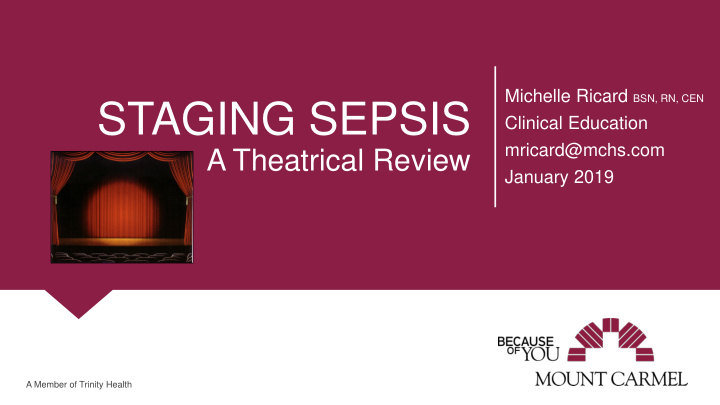



Michelle Ricard BSN, RN, CEN STAGING SEPSIS Clinical Education mricard@mchs.com A Theatrical Review January 2019 A Member of Trinity Health
MOUNT CARMEL WEST • Certified Primary Stroke Center • Accredited Network Cancer Program • Bariatric Center of Excellence • ACGME Accredited physician residency program • Mount Carmel College of Nursing
EMERGENCY DEPARTMENT • 41 beds • Approximately 60,000/year • Pediatrics represent approximately a fourth of the population treated each year in US hospital emergency departments* *Hohenhaus, S.M., Travers, D., & Mecham, N. (2008). Pediatric triage: A review of emergency education literature. Journal of Emergency Nursing , 34 (4), 308-313.
Andragogy Adult Learning A Member of Trinity Health
ANDRAGOGY – a brief look in history • 1833 – German grammar school teacher Alexander Kapp • 1926 – Eduard C. Lindeman • 1959 – Malcolm Knowles
ADULT LEARNING • The Need to Know – utility and value • The Learners Self-Concept – capable of self-direction • The Role of Experience – prior experience = rich resource • Simulation, problem solving, case studies, labs, group discussion • Readiness to Learn – dependent on relevancy of subject • Orientation to Learning – real life • Motivation – self-esteem and goal attainment Ozuah, P. (2005). First, there was pedagogy and then came andragogy. The Einstein Journal of Biology and Medicine. 21: 83-87.
Ozuah, 2005
Humans work in three modes Rule-Based Performance “If - Then Response Mode” Knowledge-Based Performance “Figuring It Out Mode” Skill-Based Performance “Auto - Pilot Mode”
(Lack of) Knowledge-based performance What You’re Doing at the Time: Problem solving in a new, unfamiliar situation. You come up with the answer by: • Using what you know (parts of different Rules) • Taking a guess • Figuring it out by trial-and-error Errors we experience: Error-Prevention Strategy • Came up with the wrong answer (a mistake) Stop and find an expert who knows the correct answer
Park, S., Robinson, P., & Bates, R. (2016). Adult learning principles and processes and their relationships with learner satisfaction: Validation of the andragogy in practice inventory (API) in the Jordanian context," Adult Education Research Conference . https://newprairiepress.org/aerc/2016/papers/28
https://www.sepsis.org/itsabouttime/
https://www.sepsis.org/itsabouttime/
SEPSIS AND PEDIATRICS Brooks, M., & Vega, C. (2016). CDC cites sepsis as a “medical emergency”. Retrieved from https://www.medscape.org/viewarticl e/868945
SEPSIS METRICS - ADULT Severe Sepsis, Septic Shock, includes Present on Admission vs Non Present on Admission System State 217 beds
Present on Admission vs Non Present on Admission System State 217 beds
LET’S TALK SIM
SIMULATION • 1 week old Matthew • Brought in by his mother who had been partying all night and woke up with her baby being blue and barely breathing • School-aged cousins had been over the last couple of days who also had coughs and runny noses • Matthew felt hot but no thermometer • HR 95 to progress to tachycardia • RR 30 • Temp 35.3 axillary • Pulse ox – 94% room air
SIMULATION • Weight 3.6 kg • Assessment: • Neck supple • Lungs clear • Abdomen soft • Cap refill > 3 seconds • Dry mucous membranes • Skin cool and dry • The stage was set…
PRE BRIEF
PRE BRIEF • Lay of the land • Vital signs • Know your resources! • Baby warmer • Crash carts • Broselow tape • IV/IO access • Medications • Respiratory emergency • Cardiac emergency
CRITICAL ACTIONS • Correctly assign ESI score of 2 • Blood cultures/VBG/POC glucose • Place in room immediately • Normal saline bolus delivered rapidly • Primary nurse assigned • Antibiotics started within 1 hour • Provider informed • Ongoing vital signs and • Oxygen started reassessments • Continuous monitoring initiated • Pressor support if nonresponsive with pulse oximetry to fluids • IV access x2 • Secure airway • Use of IO if peripheral access is • Transfer center called unattainable
AND NOW…THE PERFORMANCE
DEBRIEF
KAHOOT
SEPTRIS • FREE educational tool and INTERACTIVE • Developed by Stanford School of Medicine • http://med.stanford.edu/septris/game/SeptrisTitle.html
http://med.stanford.edu/septris/game/SeptrisTitle.html
THANK YOU AND HAPPY STAGING
MORE RESOURCES https://www.sepsis.org/itsabouttime/ Allen, P., Withey, P., Lawton, D., & Aquino, C. T. (2016). Andragogical teaching methods to enhance non-traditional student classroom engagement. i- manager’s Journal of Education Technology. 13 :2, 47-59
Recommend
More recommend